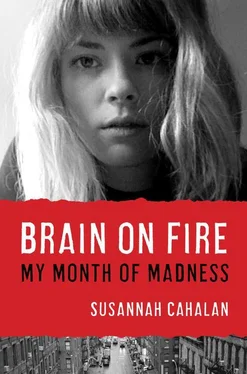SHADOWBOXER
After the surgery, I was reassigned to a shared room on the epilepsy unit. My roommate, a woman in her early thirties, suffered from seizures induced during alcohol consumption (though seizures occur commonly with alcohol withdrawal, sometimes drinking can induce seizures). She was constantly begging the staff to allow her to drink some wine so that they could record the seizure. They refused.
The results of the brain biopsy confirmed what the team had expected: my brain was inflamed. Dr. Najjar’s slides showed armies of angry inflammatory cells from my immune system attacking nerve cells in the brain, a signature of encephalitis.
There was a time, not so long ago, when neurologists believed that the brain was immunoprivileged, meaning it was completely separate from the immune system’s lymphocytes; now doctors use the careful phrasing “immuno-different.” The blood-brain barrier (BBB) is a dense patchwork quilt of vessels that serve as gates, regulating the passage of substances, like bacteria, chemicals, and drugs, from the blood to the brain. 36Researchers have discovered that the BBB does allow for certain B-cells and T-cells to squeeze through, in a process called diapedesis, to do regular “checkups.” But this was no routine checkup. The immune cells it had let through, which were supposed to protect the body, were in mid-blitz. This was the evidence Dr. Najjar had needed: I was in the grip of some kind of autoimmune disease.
Now that they had a hazy diagnosis, the doctors could move ahead with the first phase of treatment, intravenous steroids, a form of immunotherapy that suppresses inflammation created by the body’s immune system. A clear plastic bag of Solu-Medrol, an IV steroid, hung beside my bed for three days of intensive therapy. It was administered every six hours on an IV pump. These steroids, called corticosteroids, subdue the inflammation and quiet the immune system, which in turn quells future inflammation. 37As the steroids seeped into my system, they switched off inflammatory chemicals called cytokines. Dr. Najjar approved the highest dosage possible for three days. Then he would convert me to 60 milligrams of the oral steroid prednisone, which would continue, more gently, to quell the inflammation over time.
Because corticosteroids interact with blood-sugar levels, among other things, I developed a temporary form of type II diabetes. Though the doctors changed my menu, providing only sugar-free Jell-O as a sweet snack, my parents remained oblivious to the dangers of my Easter jellybeans, as I continued to munch away. Since I was placed on bed rest following surgery, the nurses applied thigh-high compression boots, which blow up and deflate, pumping blood through my legs and mimicking the act of contracting and expanding during physical activity. But they made my legs itchy and sweaty, as I explained to anyone who would listen, and I kicked them off every night.
Despite the new intensive steroid treatment, my condition did not seem to improve right away. In fact, it worsened; the abnormal nightly movements and undefined panic attacks increased. My father wrote about my continued difficulties in the logbook that he and my mom shared: “She had a strange smirking expression on her face. She tensed up,” he wrote. “Arms stretched out straight, grimace, tenseness, shakes.”
But I could still pull myself together for visitors. Hannah arrived soon after the surgery and stifled a laugh when she saw my strange white turban of bandages.
I was a good sport about it. “I’m going to be bald!” I said, smiling, and popped an Easter jellybean into my mouth.
“What do you mean? Did they shave your scalp?”
“Bald!”
“Maybe you need Propecia.” We both cracked up.
EEG video, April 12, 8:12 a.m., 7 minutes
I’m wearing a white surgical cap, reclining with my legs folded over as if I’m sunbathing. My pink backpack containing the EEG box rests on my lower stomach. I get up and walk to the door. My movements are halting and painfully slow. My left arm is outstretched.
“Would that be the little green button?” my mother asks a nurse from off-camera, referring to the seizure/event button tied to the bedside rail. She enters the frame and sits by the window.
I get back into bed. My mother gets up and hovers over me and then pushes the nurse’s button. Nurse Edward arrives moments later and starts a neurological exam, miming the action he wants me to follow, extending his arms out. Gradually I follow his lead. He taps on my left index finger and tells me to close my eyes and touch it to my face. After a moment, I do. He repeats it on the other side.
When Edward leaves, I reach for the sheets. It takes a full ten seconds for me to lie down. Meanwhile, my mother looks nervous. She checks her purse, crosses and uncrosses her legs, all the while keeping an eye on me.
End of video.
By our third night in the shared room, the woman next to me had a seizure. Somehow she had convinced the medical staff to allow her to drink wine. Since they had what they needed, a physical recording of a seizure, she was released shortly thereafter.
CHAPTER 29
DALMAU’S DISEASE
Dr. Russo arrived later that day to explain which diseases they could now tick off the list of possibilities, including hyperthyroidism, lymphoma, and Devic’s disease, a rare disease similar symptomatically to multiple sclerosis. They still suspected that I had been exposed to hepatitis, which can cause encephalitis, but they didn’t have proof.
After the conversation, my mother followed Dr. Russo into the hallway. “So what do you think it is?” my mom prodded.
“Actually, Dr. Najjar and I have a bet going.”
“What kind of a bet?”
“Well, Dr. Najjar thinks the inflammation is caused by autoimmune encephalitis; I think it’s paraneoplastic syndrome.” 38When my mother pressed for more details, Dr. Russo explained that paraneoplastic syndrome is a consequence of an underlying cancer, most often associated with lung, breast, or ovarian cancer. The symptoms—psychosis, catatonia, and so forth—are not associated with the cancer but with the immune system’s response to it. As the body gears up to attack the tumor, it sometimes begins to target healthy parts of the body, such as the spine or the brain. “I think because of her history of melanoma, it makes sense,” Dr. Russo concluded.
This was not what my mother wanted to hear. Cancer had always been the greatest fear, the word she dared not utter. Now this doctor was tossing it off casually as part of a bet.
Meanwhile, two plastic tubes, placed securely in Styrofoam boxes, had arrived at the University of Pennsylvania, transported in a refrigerator in the back of a FedEx truck; one contained transparent cerebrospinal fluid, as clear as unfiltered water, and another held blood, which started to look like dehydrated urine as, over time, the red blood cells dropped to the bottom. The test tubes were coded 0933, labeled with my initials, SC, and placed in a negative-80 degree freezer waiting for the lab to conduct its tests. They were addressed to the lab run by neuro-oncologist Dr. Josep Dalmau, whom Dr. Najjar had mentioned during his first visit and whom Dr. Russo had since e-mailed to ask if he would take a look at my case.
Four years earlier, in 2005, Dr. Dalmau had been the senior author on a paper in the neuroscience journal Annals of Neurology that focused on four young women who had developed prominent psychiatric symptoms and encephalitis. All had white blood cells in their cerebrospinal fluid, confusion, memory problems, hallucinations, delusions, and difficulty breathing, and they all had tumors called teratomas in their ovaries. But the most remarkable finding was that all four patients had similar antibodies that appeared to be reacting against specific areas of the brain, mainly the hippocampus. Something about the combination of the tumor and the antibodies was making these women very sick.
Читать дальше













